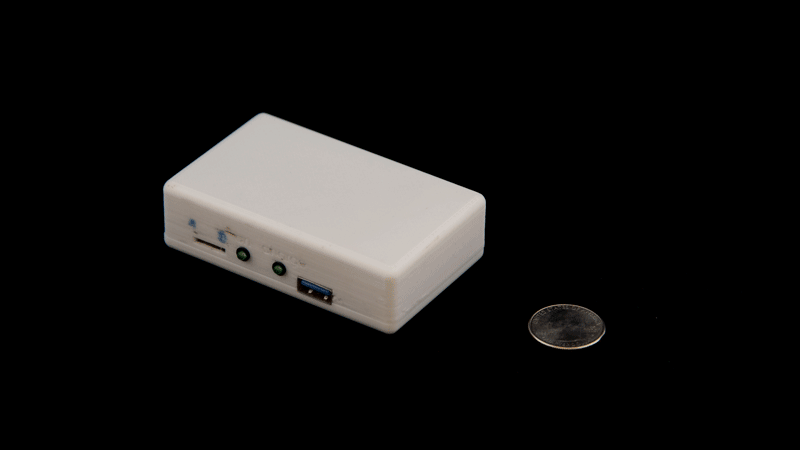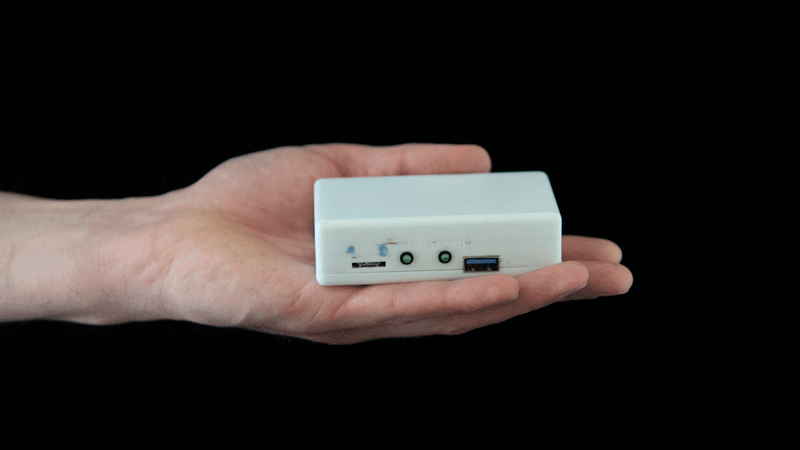We are making available Pilot Tone devices, upon request.
The Pilot Tone transmitter is a compact stand-alone device that can be used to track motion during MRI exams.
The Pilot Tone transmitter emits signal at a single frequency outside the imaging bandwidth but inside the oversampled readout band. The received amplitude of the Pilot Tone signal is modulated by the subject’s motion and detected by radiofrequency coils alongside regular MR signal during readout, creating a real-time reference.

The 3T Pilot Tone signal has a frequency of 123.355 MHz, intentionally offset by 155 kHz from the 123.2 MHz Larmor frequency of Siemens 3T MRI scanners. The signal is generated by the fifth harmonic of a 24.671 MHz standard clock oscillator, filtered through a Chebyshev bandpass filter to suppress all undesired harmonics, and radiated by a small non-resonant loop antenna. Two pairs of crossed diodes protect the oscillator from the MR system’s high-powered transmit pulse. The signal’s amplitude can be adjusted with a built-in potentiometer.

The device, powered by an internal rechargeable battery, is housed in a 3D-printed case about the size of a deck of cards. The Pilot Tone transmitter can be easily attached to the outside of an MRI scanner (e.g. with adhesive tape) or placed anywhere in the scanner room. See related publications for more information about how we have used this technology to detect, track, and correct respiratory motion in MRI.
Contact and Requests
Pilot Tone transmitters are available upon written request, typically within 4-6 weeks. Post-processing software for the Pilot Tone is also available. Scientists requesting a device can expect that our research team will share its expertise with them. Interested researchers should email inquiries to Douglas Brantner, MS, at Douglas.Brantner@nyulangone.org and include the phrase “pilot tone” in the subject line.
Related Publications
Free-breathing radial imaging using a pilot-tone radiofrequency transmitter for detection of respiratory motion.
Magn Reson Med. 2021 May;85(5):2672-2685. doi: 10.1002/mrm.28616
Respiratory Motion Detection and Correction for MR Using the Pilot Tone: Applications for MR and Simultaneous PET/MR Examinations.
Invest Radiol. 2020 Mar;55(3):153-159. doi: 10.1097/RLI.0000000000000619
Tracking Respiratory Motion Throughout Arbitrary MRI Sequences via Pilot Tone Navigation.
Proc Intl Soc Mag Reson Med. 2018;26:4108
PET-MR Motion Correction of Entire Listmode Data Sets Using Pilot Tone Navigation.
Proc Intl Soc Mag Reson Med. 2017;25:3897
Contributors
The design of the 3T Pilot Tone was adapted by Jan Paška from a 1.5T Pilot Tone version created by Jan Bollenbeck (Siemens). The 3T Pilot Tone was tailored to printed circuit board (PCB) assembly by Jan Paška and Leanna Pancoast.
Post-processing software for extracting Pilot Tone signal from raw data and correcting image data was written by Eddy Solomon for the RAVE sequence. Extension to other pulse sequences was created by Mahesh Bharath Keerthivasan (Siemens).
Related Story
Imaging scientists around the world are looking into this simple transmitter to deal with breathing motion in MRI scans. NYU Langone offers resources to kickstart their research.

